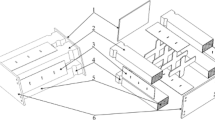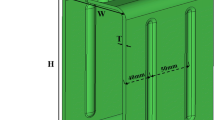Abstract
To improve the crashworthiness of subway vehicles, a composite energy-absorbing structure (EAS) is designed by coupling a thin-walled metal tube and aluminium honeycomb structures. On this basis, the effectiveness of the composite structure and aluminium honeycomb finite element model (FEM) is validated by conducting trolley impact tests and quasi-static compression experiments. Based on the verified FEM, the surrogate models, including polynomial response surface (PRS), Kriging, radial basis function (RBF) and supported vector regression (SVR), are established to get the relationship between crashworthiness indexes and design variables. Then, the most accurate model is employed for crashworthiness optimisation through comparing the accuracies of these four models. Owing to the mutually effects among components of the composite EAS and the relatively complex mathematical formulae acquired by the high-precision surrogate model, a hybrid particle swarm optimisation (HPSO) algorithm is put forward. The performance of the HPSO is tested by a typical engineering optimisation case. The results indicate that the HPSO algorithm presents various advantages (e.g. strong global search capability, high optimisation accuracy, etc.). By optimising the mathematical model of the composite EAS, the optimal configurations of the structure are obtained, which confirms that the HPSO algorithm has favourable applicability and performance in the crashworthiness optimisation of the EASs for subway vehicles.













Similar content being viewed by others
References
Alavi Nia A, Fallah Nejad K, Badnava H, Farhoudi HR (2012) Effects of buckling initiators on mechanical behavior of thin-walled square tubes subjected to oblique loading. Thin-Walled Struct 59:87–96
Alavi Nia A, Parsapour M (2013) An investigation on the energy absorption characteristics of multi-cell square tubes. Thin-Walled Struct 68:26–34
Arasomwan MA, Adewumi AO (2013) On the performance of linear decreasing inertia weight particle swarm optimization for global optimization. Sci World J 2013:1–12
Baroutaji A, Gilchrist MD, Smyth D, Olabi AG (2015) Crush analysis and multi-objective optimization design for circular tube under quasi-static lateral loading. Thin-Walled Struct 86:121–131
Chen S, Yu H, Fang J (2018) A novel multi-cell tubal structure with circular corners for crashworthiness. Thin-Walled Struct 122:329–343
Chen Y, Bai Z, Zhang L, Wang Y, Sun G, Cao L (2017) Crashworthiness analysis of octagonal multi-cell tube with functionally graded thickness under multiple loading angles. Thin-Walled Struct 110:133–139
Clarke SM, Griebsch JH, Simpson TW (2005) Analysis of support vector regression for approximation of complex engineering analyses. J Mech Des 127:1077–1086
Coello Coello CA, Mezura Montes E (2002) Constraint-handling in genetic algorithms through the use of dominance-based tournament selection. Adv Eng Inform 16(3):193–203
Djamaluddin F, Abdullah S, Ariffin AK, Nopiah ZM (2015) Optimization of foam-filled double circular tubes under axial and oblique impact loading conditions. Thin-Walled Struct 87:1–11
Duddeck F, Hunkeler S, Lozano P, Wehrle E, Zeng D (2016) Topology optimization for crashworthiness of thin-walled structures under axial impact using hybrid cellular automata. Struct Multidiscip Optim 54(3):415–428
Esfahlani SS, Shirvani H, Nwaubani S, Shirvani A, Mebrahtu H (2013) Comparative study of honeycomb optimization using kriging and radial basis function. Theor Appl Mech Lett 3(3):1–5
Fazilati J, Alisadeghi M (2016) Multiobjective crashworthiness optimization of multi-layer honeycomb energy absorber panels under axial impact. Thin-Walled Struct 107:197–206
Forsberg J, Nilsson L (2005) On polynomial response surfaces and kriging for use in structural optimization of crashworthiness. Struct Multidiscip Optim 29(3):232–243
Gao Q, Zhao X, Wang C, Wang L, Ma Z (2018) Multi-objective crashworthiness optimization for an auxetic cylindrical structure under axial impact loading. Mater Des 143:120–130
Hallquist JO (2006) LS-DYNA theory manual. Livermore Software Technology Corporation, California
Huang F, Wang L, He Q (2007) An effective co-evolutionary differential evolution for constrained optimization. Appl Math Comput 186(1):340–356
Hussein RD, Ruan D, Lu G, Guillow S, Yoon JW (2017) Crushing response of square aluminium tubes filled with polyurethane foam and aluminium honeycomb. Thin-Walled Struct 110:140–154
Kohar CP, Mohammadi M, Mishra RK, Inal K (2015) Effects of elastic–plastic behaviour on the axial crush response of square tubes. Thin-Walled Struct 93:64–87
Li Z, Duan L, Chen T, Hu Z (2018) Crashworthiness analysis and multi-objective design optimization of a novel lotus root filled tube (LFT). Struct Multidiscip Optim 57(2):865–875
Mahdavi M, Fesanghary M, Damangir E (2007) An improved harmony search algorithm for solving optimization problems. Appl Math Comput 188(2):1567–1579
Peng Y, Deng W, Xu P, Yao S (2015) Study on the collision performance of a composite energy-absorbing structure for subway vehicles. Thin-Walled Struct 94:663–672
Peng Y, Wang S, Yao S, Xu P (2017) Crashworthiness analysis and optimization of a cutting-style energy absorbing structure for subway vehicles. Thin-Walled Struct 120:225–235
Simpson TW, Mauery TM, Korte JJ, Mistree F (2015) Kriging models for global approximation in simulation-based multidisciplinary design optimization. AIAA J 39(12):2233–2241
Song X, Sun G, Li G, Gao W, Li Q (2013) Crashworthiness optimization of foam-filled tapered thin-walled structure using multiple surrogate models. Struct Multidiscip Optim 47(2):221–231
Sun G, Huo X, Chen D, Li Q (2017a) Experimental and numerical study on honeycomb sandwich panels under bending and in-panel compression. Mater Des 133:154–168
Sun G, Li G, Gong Z, He G, Li Q (2011) Radial basis functional model for multi-objective sheet metal forming optimization. Eng Optim 43(12):1351–1366
Sun G, Li G, Stone M, Li Q (2010) A two-stage multi-fidelity optimization procedure for honeycomb-type cellular materials. Comput Mater Sci 49(3):500–511
Sun G, Li S, Liu Q, Li G, Li Q (2016) Experimental study on crashworthiness of empty/aluminum foam/honeycomb-filled CFRP tubes. Compos Struct 152:969–993
Sun G, Zhang H, Fang J, Li G, Li Q (2017b) Multi-objective and multi-case reliability-based design optimization for tailor rolled blank (TRB) structures. Struct Multidiscip Optim 55(5):1899–1916
Tan Y, Zhu YC (2010) Fireworks algorithm for optimization. In: Tan Y, Shi YH, Tan KC (eds) Lecture notes in computer science. Springer-Verlag Berlin, Berlin, pp 355–364
Tsai S, Sun T, Liu C, Hsieh S, Wu W, Chiu S (2010) An improved multi-objective particle swarm optimizer for multi-objective problems. Expert Syst Appl 37(8):5872–5886
Wang Z, Tian H, Lu Z, Zhou W (2014) High-speed axial impact of aluminum honeycomb – experiments and simulations. Compos Part B 56:1–8
Wang Z, Yao S, Lu Z, Hui D, Feo L (2016) Matching effect of honeycomb-filled thin-walled square tube—experiment and simulation. Compos Struct 157:494–505
Xie S, Zhou H (2015) Analysis and optimisation of parameters influencing the out-of-plane energy absorption of an aluminium honeycomb. Thin-Walled Struct 89:169–177
Xie S, Li H, Yang W, Wang N (2018) Crashworthiness optimisation of a composite energy-absorbing structure for railway vehicles. Struct Multidiscip Optim 57(4):1793–1807
Xie S, Zhou H (2014a) Impact characteristics of a composite energy absorbing bearing structure for railway vehicles. Compos Part B 67:455–463
Xie S, Zhou H (2014b) Research on the crashworthy structures of subway vehicles. International Journal of Crashworthiness 19(6):555–566
Xie S, Zhou H (2014c) Multi-objective optimisation of a vehicle energy absorption structure based on surrogate model. J Cent South Univ 21(6):2539–2546
Xu P, Yang C, Peng Y, Yao S, Xing J, Li B (2016) Cut-out grooves optimization to improve crashworthiness of a gradual energy-absorbing structure for subway vehicles. Mater Des 103:132–143
Yamashita M, Gotoh M (2005) Impact behavior of honeycomb structures with various cell specifications—numerical simulation and experiment. International Journal of Impact Engineering 32(1):618–630
Yang S, Qi C (2013) Multiobjective optimization for empty and foam-filled square columns under oblique impact loading. International Journal of Impact Engineering 54:177–191
Yao S, Xiao X, Xu P, Qu Q, Che Q (2018) The impact performance of honeycomb-filled structures under eccentric loading for subway vehicles. Thin-Walled Struct 123:360–370
Yin H, Wen G, Hou S, Qing Q (2013) Multiobjective crashworthiness optimization of functionally lateral graded foam-filled tubes. Mater Des 44:414–428
Yin H, Wen G, Liu Z, Qing Q (2014) Crashworthiness optimization design for foam-filled multi-cell thin-walled structures. Thin-Walled Struct 75:8–17
Yin H, Xiao Y, Wen G, Qing Q, Deng Y (2015) Multiobjective optimization for foam-filled multi-cell thin-walled structures under lateral impact. Thin-Walled Struct 94:1–12
Yong D, Wu C, Guo H (2015) Particle swarm optimization algorithm with adaptive chaos perturbation. Cybernetics and Information Technologies 15(6):70–80
Yildiz AR (2009) A novel particle swarm optimization approach for product design and manufacturing. Int J Adv Manuf Technol 40(5–6):617–628
Zeng D, Duddeck F (2017) Improved hybrid cellular automata for crashworthiness optimization of thin-walled structures. Struct Multidiscip Optim 56(1):101–115
Zhao D, Xue D (2010) A comparative study of metamodeling methods considering sample quality merits. Struct Multidiscip Optim 42(6):923–938
Zhong ZH (1993) Finite element procedures for contact-impact problems. Oxford University Press, Oxford, pp 96–213
Zhou H, Xu P, Xie S (2017) Composite energy-absorbing structures combining thin-walled metal and honeycomb structures. Journal of Rail and Rapid Transit 231(4):394–405
Zhu G, Li S, Sun G, Li G, Li Q (2016) On design of graded honeycomb filler and tubal wall thickness for multiple load cases. Thin-Walled Struct 109:377–389
Zhu P, Pan F, Chen W, Zhang S (2012) Use of support vector regression in structural optimization: application to vehicle crashworthiness design. Math Comput Simul 86:21–31
Acknowledgments
This research was undertaken at Key Laboratory of Traffic Safety on Track (Central South University), Ministry of Education, China. The authors gratefully acknowledge the support from the National Natural Science Foundation of China (Grant no. 51775558), the supported by Innovation-Driven Project of Central South University (No. 2018CX023) and the support from the Shenghua Yu-ying Talents Program of the Central South University (Principle Investigator: Prof. Suchao Xie). The corresponding author would like to acknowledge the China Scholarship Council/University of Manchester Joint Scholarship for PhD study (201706370205).
Author information
Authors and Affiliations
Corresponding author
Appendix: The response model expressions
Appendix: The response model expressions
Rights and permissions
About this article
Cite this article
Xie, S., Li, H., Yang, C. et al. Crashworthiness optimisation of a composite energy-absorbing structure for subway vehicles based on hybrid particle swarm optimisation. Struct Multidisc Optim 58, 2291–2308 (2018). https://doi.org/10.1007/s00158-018-2022-3
Received:
Revised:
Accepted:
Published:
Issue Date:
DOI: https://doi.org/10.1007/s00158-018-2022-3




